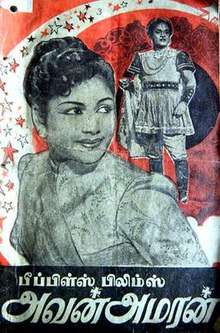Avan Amaran
| Avan Amaran | |
|---|---|
 Poster | |
| Directed by | Sundaram Balachander |
| Produced by | Nagercoil S. Nagarajan |
| Written by | Nagercoil S. Nagarajan |
| Starring | K. R. Ramaswamy |
| Music by | T. M. Ibrahim |
| Cinematography | Nemai Ghosh[1] |
Production company |
People's Films[1] |
Release date | 23 May 1958 |
Running time | 199 minutes[1] |
| Country | India |
| Language | Tamil |
Avan Amaran (lit. He is immortal) is a 1958 Indian Tamil language film produced and written by Nagercoil S. Nagarajan, and directed by Sundaram Balachander.[2][1]
Plot
Mariamma (Kannamba), a poor woman, struggles to bring up her only child, a son Arul (Ramaswamy), who does odd jobs to stay afloat. An accident disables her and life becomes harsh for her. The boy has a classmate Lily (Rajasulochana), the daughter of a mill owner (Balaiah). The two fall in love and marry against the wishes of the dictatorial mill owner. The boy wins a scholarship, goes to England and returns as a barrister. He dedicates himself to the cause of the poor, struggling underpaid workers exploited by the mill owner. The mill owner creates much trouble because his daughter defied him by marrying the labour leader. Further problems arise when the workers demand bonus and better wages and go on strike. The mill owner indulges in several subterfuges by setting fire, beating up workers and in the process the labour leader dies, leaving his widow and a young child. The mill owner's daughter takes up the cause of her idealistic husband and dedicates her life to the welfare of the mill workers.[3][2]
Cast
- K. R. Ramaswamy as Arul
- P. Kannamba as Arul's mother
- Rajasulochana as Lily
- T. S. Balaiah as Lily's father
Production
Avan Amaran was shot at the Newtone, Paramount, and Revathi studios in Chennai.[2] The scene where labourers protest on a bridge was shot at a bridge near Fort St. George, Madras (now Chennai).[4]
Soundtrack
Music was composed by T. M. Ibrahim. Lyrics were by A. Maruthakasi, Ku. Sa. Krishnamurthi, Kambadasan, Surabhi, Ku. Ma. Balasubramaniam and Kuyilan. Singer is K. R. Ramaswamy. Playback singers are C. S. Jayaraman, Seerkazhi Govindarajan, A. M. Rajah, Jikki and A. P. Komala.[5]
| No. | Song | Singers | Lyricist | Length |
| 1 | Vaanmadhi Nee Arivaai | Seerkazhi Govindarajan & Jikki | Ku. Ma. Balasubramaniam | 03:34 |
| 2 | Kanmaniye Innamudhe Karkandu Paage | Jikki | Ku. Ma. Balasubramaniam | 03:01 |
| 3 | Ezhaiyai Kozhai Endru Ninaikkudhu | K. R. Ramaswamy | Ku. Sa. Krishnamoorthi | 02:22 |
| 4 | Varum Kaalam Ulagam Namadhendre | Jikki & group | A. Maruthakasi | 03:24 |
| 5 | Kaalanaa Minjaadhaiyaa Kaalanaa Minjaadhaiyaa | Seerkazhi Govindarajan, A. P. Komala & group | 03:14 | |
| 6 | Aniyaayam Indha Ulagile | C. S. Jayaraman | 04:12 | |
| 7 | Kanneer Sindhaadhe Kavalai Kollaadhe | Jikki | 03:11 | |
| 8 | Yezhaigal Vaazhvil .. Van Pasiyaale Thudikkiraar Inge | K. R. Ramaswamy | Kuyilan | |
| 9 | Aasiyaavin Jyothiyaaga | Group song | ||
| 10 | Kanavo Sol Kaadhal | K. R. Ramasamy & Jikki | Kambadasan | |
| 11 | Dhaam Dhoom Thagatham | A. M. Rajah & A. P. Komala | Surabhi |
Release and reception
Avan Amaran was released on 23 May 1958.[6] Film historian Randor Guy wrote that the film would be "Remembered for the leftist message-oriented story, screenplay and dialogue, the performances by Ramasami, Kannamba, Balaiah and Rajasulochana, and Balachandar's deft direction."[2]
References
- 1 2 3 4 Rajadhyaksha & Willemen 1998, p. 353.
- 1 2 3 4 Guy, Randor (12 May 2012). "Avan Amaran 1958". The Hindu. Archived from the original on 23 January 2017. Retrieved 23 January 2017.
- ↑ Baskaran 1996, p. 123; Rajadhyaksha & Willemen 1998, p. 353.
- ↑ Baskaran 1996, p. 123.
- ↑ G. Neelamegam. Thiraikalanjiyam — Part 1 (in Tamil). Manivasagar Publishers, Chennai 108 (Ph:044 25361039). First edition December 2014. p. 137.
- ↑ Film News Anandan (2004). Sadhanaigal Padaitha Thamizh Thiraipada Varalaru [Tamil film history and its achievements] (in Tamil). Chennai: Sivagami Publishers. Archived from the original on 21 April 2017.
Bibliography
- Baskaran, S. Theodore (1996). The eye of the serpent: an introduction to Tamil cinema. East West Books.
- Rajadhyaksha, Ashish; Willemen, Paul, eds. (1998) [1994]. Encyclopaedia of Indian Cinema (PDF). Oxford University Press. ISBN 019-563579-5.
External links
- Avan Amaran on IMDb